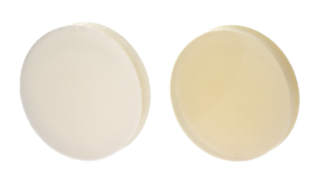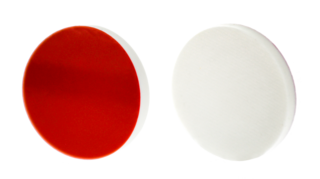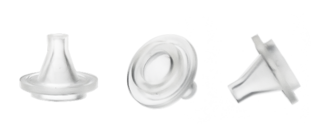Available septum materials and their properties
- Silicone/PTFE
- Rubber/PTFE
- PFAS Analysis
- ZeroSept® - phthalate free septum
Silicone/PTFE
ms-Pure septum: non-pigmented silicone/PTFE septum
With the increasing sensitivity of the analytical instruments, extractable substances from the septum may contaminate the sample. The ms-Pure silicone/PTFE septum is produced from a natural non-pigmented silicone/PTFE. Tests show that it is 60 % cleaner than „standard“ silicone/PTFE septums on the market.
- non-pigmented silicone of highest quality
- low bleeding
- resists coring
- excellent re-seal ability
- intended for multiple injections
- low compression set for storage reliability
This septum type is available with all closure types for autosampler vials including headspace.
Pigmented silicone/PTFE septum
In the days when septum and caps were assembled by hand in the laboratory, it helped when the PTFE side of the septum was easily identified. Therefore the silicone and PTFE was pigmented in different colours. With the increasing sensibility of the analytical instruments, the pigmentation may interfere with the analysis.
This septum type is available with all closure types for autosampler vials and our economic blueLine.
Rubber/PTFE
Natural rubber/PTFE septum
The natural rubber/PTFE septum was established as standard septum in the days when silicone was much more expensive than today.
This septum type is available with 11 mm aluminium crimp caps.
Butyl rubber and Butyl rubber/PTFE septum and stoppers
Butyl is a synthetic caoutchouc and is temperature resistant from -40°C to 120°C.
Without the PTFE layer this septum is an economic alternative for non-critical analysis (eg. in breweries or for blood alcohol analysis).
With a PTFE layer this septum is also suitable for critical analysis.
This septum type is available with the economic blueLine 11 mm aluminium crimp caps and 20 mm aluminium crimp caps as well as for injection stoppers and lyophilisation stoppers.
PFAS Analysis
Septa suitable for PFAS testing
Classic chromatography septa have a PTFE coating on the side facing the sample. However, the PTFE would contaminate the sample in the PFAS analysis. Polypropylene or Polyimide is used instead of PTFE. Butyl caps are also available.
These septum types are available with snap caps and 9 mm screw caps.
Another option is our KapOni-Pure caps (ND9) with a funnel instead of a septum. The funnel is made of inert, plasticiser-free polypropylene, which can be used in a wide temperature range from -0 °C to 100 °C. The funnel guides the syringe needle through the thin membrane of the injection site. Due to its shape, the funnel prevents evaporation of the sample even after multiple injections.
The funnel KapOni-Pure is available with 9 mm screw caps.
ZeroSept® - phthalate free septum
ZeroSept® Air
The ZeroSept® Air septum gains its excellent sealing qualities from an air cushion trapped between two layers of high-purity PTFE foil which makes it also ideal for multiple injections.
When using a silicone or rubber septum, the needle piercing the septum will always carry some septum material into the sample which may lead to interfering peaks in the chromatogram. The ZeroSept® Air septum eliminates the risk of interfering peaks through coring. Tests proofed that the ZeroSept® Air septum also shows adequate sealing qualities over a period of 24 hours when used with multiple injections.
This septum type is available with 11 mm and 20 mm aluminium crimp caps.
ZeroSept® with O-ring and aluminium-/or PTFE foil
An O-ring made from fluoroplastic and with the same thickness as a common septum assures that the cap rests optimally on the vial head rim. In addition the crimping tool has not to be completely reset due to this place holder.
ZeroSept® ALUmono-O
Phthalate free septum consisting of an O-ring made from fluoroplastic and a thin aluminium foil.
ZeroSept® PTFEmono-O
Septum consisting of an O-ring made from fluoroplastic and a thin PTFE foil.
ZeroSept® PTFEmono
Septum consisting of thin PTFE foil.
These septum types are available with 11 mm aluminium crimp caps.




